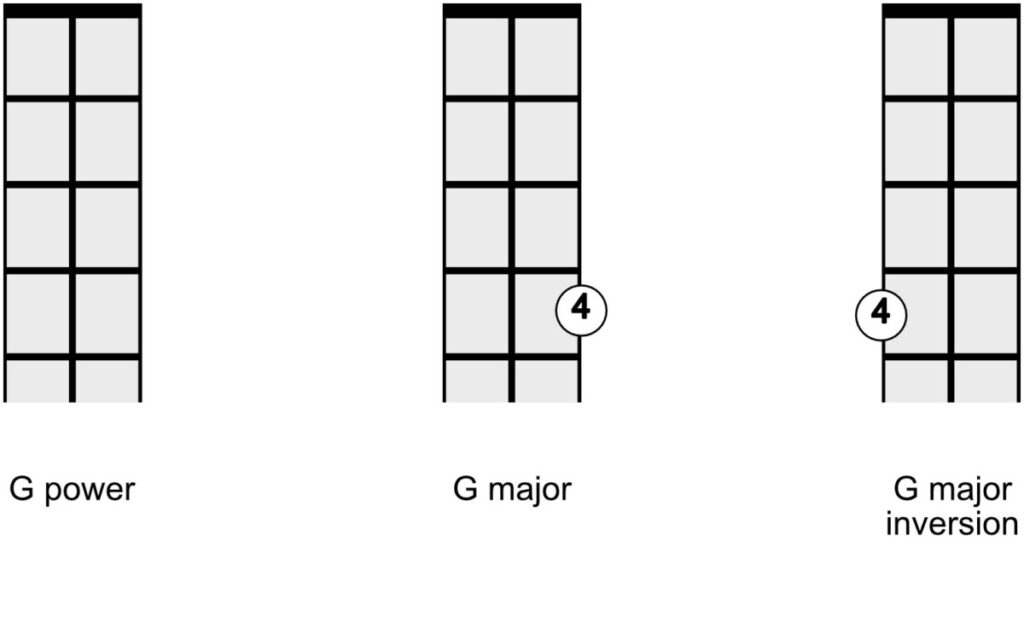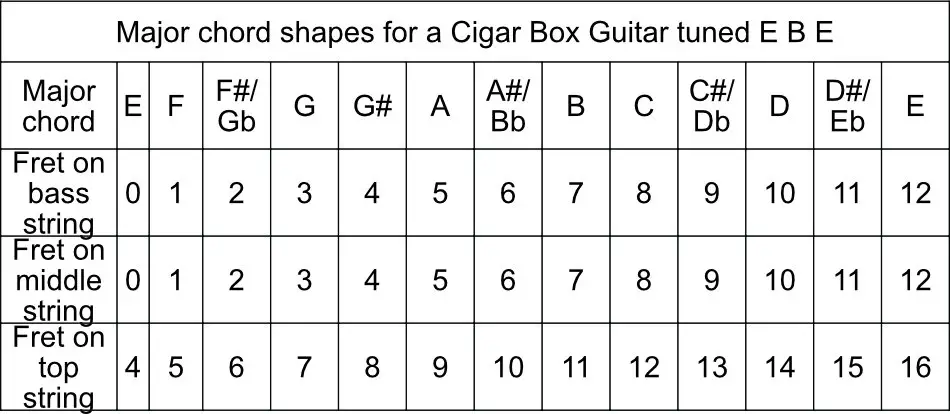To add a third note to turn the open string G power chord into G major, we can use our little finger ( pinkie) to press down on the top string to add the 3rd note of the scale. This is not found on the 3rd fret, but on the 4th. This moveable shape can be used higher up the fretboard.
There are several ways to play the major chord on a Cigar Box Guitar and I am going to give you tables of fret numbers and chord diagrams and also explain how we get to these patterns.
Fret Numbers Are Not The Same as Note Numbers
There are lots of times that we need to be careful about whether we mean a particular note of the scale or a particular fret on the guitar and this is one of them. It’s easy to get a bit confused, so I will explain in detail why we need the 4th fret for the the 3rd note of the scale.
For a G major chord, we need to add the major third which is the note B ( from G A B) , so we need to count up the frets to find that B.
| fret on G string | 0 | 1 | 2 | 3 | 4 | 5 | 6 | 7 | 8 | 9 | 10 | 11 | 12 |
| note letter | G | G#/Ab | A | A#/Bb | B | C | C#/Db | D | D#/Eb | E | F | F#/Gb | G |
That B note that we need is on the 4th fret
So to play G major, we play 0 0 4:

Notice that we can put that B on the bass note if we prefer and play an inversion of the chord: B D G instead of G D B. A chord inversion is just the same notes in a different order.
Transposing The G Major Chord Into A Major
Now we know how to play a G power chord and a G major chord , we can use this knowledge to find any major chord on the 3 string cigar box guitar.
Let’s look at the A chords as an example:
We play the A power chord by fretting the second fret with our first finger flattened across all three strings ( or by lining up our first, second and third strings across the second fret)
This can be written 2 2 2. To play the A major chord, we need to add our pinkie onto the 4th fret above the barre. This is actually the 6th fret. So the A major chord is written 2 2 6:

We can use a vary similar adding of a little finger to change a barred power chord into a minor key. See this article here: How Do I Play Minor Chords On A Cigar Box Guitar?
Using The Movable Major Chord Shape
I have gone into so much detail to explain this so that you can learn to work out chord shapes for yourself but I also want to provide a table to help you out in the beginning. You can download it as a JPEG on the button:

Major Chord Shapes For A Guitar In Open E Tuning
Here is the same table transposed for those of you that like to play in E B E tuning:

Can We Change The 7 5 7 Power Chord Shape To Make The Major Chord?
We can change it, but we end up losing the root or 1st note to make a playable chord. Here is what I mean:
If you haven’t read my article yet on the other power chord shape (the 7 5 7) you can read it here: Power Chords On A Guitar With 3 Strings
Here is the chart with those power chords.
| FRET NUMBER OF MIDDLE STRING | 0 | 1 | 2 | 3 | 4 | 5 | 6 | 7 | 8 | 9 | 10 | 11 | 12 |
| FRET NUMBER OF OUTSIDE TWO STRINGS | 2 | 3 | 4 | 5 | 6 | 7 | 8 | 9 | 10 | 11 | 12 | 13 | 14 |
| POWER CHORD | D | D#/Eb | E | F | F#/Gb | G | G#/Ab | A | A#/Bb | B | C | C#/Db | D |
| MIDDLE STRING | D | D#/Eb | E | F | F#/Gb | G | G#/Ab | A | A#/Bb | B | C | C#/Db | D |
| BASS AND TOP STRING | G | G#/Ab | A | A#/Bb | B | C | C#/Db | D | D#/Eb | E | F | F#/Gb | G |
Is there a way to change this shape into the major chord? Remember we need to add the major 3rd.
For the G chord that means adding a B. We can either play the B on the 9th fret of the middle string or the 6th fret of the outer 2 strings.
This gives us 7 5 9 which is pretty impossible to play or 7 4 7 which is a bit less of a stretch. The only trouble with this shape is that we lose the root or 1st note. Sometimes this will work and so I do use this shape occasionally, but let’s see if there is a better way of playing the major chord.
A Great Moveable Shape For The Major Chords On Cigar Box Guitar

All of these chord shapes can be mirrored if you prefer. That is swap the bass and top notes over.

I’m going to show you how we work out moveable shapes so read on if you want to see how I arrived at the table above.
So let’s look at how else we can play a major chord apart from adding a little finger on the barred power chord.
I’m taking the example of A major this time since then any shape we make without any open strings can be moved up the fretboard.
A major requires the notes A C# and E. Let’s look at the table of notes on the guitar tuned to G D G:
| FRET NUMBER | 0 | 1 | 2 | 3 | 4 | 5 | 6 | 7 | 8 | 9 | 10 | 11 | 12 |
| BASS STRING | G | G#/Ab | A | A#/Bb | B | C | C#/Db | D | D#/Eb | E | F | F#/Gb | G |
| MIDDLE STRING | D | D#/Eb | E | F | F#/Gb | G | G#/Ab | A | A#/Bb | B | C | C#/Db | D |
| TOP STRING | G | G#/Ab | A | A#/Bb | B | C | C#/Db | D | D#/Eb | E | F | F#/Gb | G |
- A is on the outer 2 strings at the 2nd fret and the inner string at the 7th fret
- C# is on the outer 2 strings at the 6th fret and the inner string at the 11th fret
- E is on the outer 2 strings at the 9th fret and the inner string at the 2nd fret
When I’m building a chord there a few factors I like to consider in this order:
- The chord needs to be playable without too much contortion or stretch
- Ideally I like the bass note to be the root or 1st note of the scale
- I like a shape to be something I will remember
So for the first point, I look for notes that are on similar fret numbers as this means not too much stretch ( but the notes still might be too tricky to reach)
At a first look 6 7 9 looks possible or 9 7 6 and I prefer the sound and the playability of the 2nd version:

You can play the bass note, fretting with the 3rd or 4th finger. I often play with the 4th finger lower down the fretboard and with the 3rd finger higher up the fretboard.
The other option with the A in the bass is 2 6 9 and this is just not playable so I can’t put my a in the bass, but I like the sound of the chord shape in the diagram above so that’s fine. ( As a side note, try playing 2 2 2 followed by 2 6 9 and you will hear the difference between the A power chord and the A major chord. You’ll see why we love the power chords- a very similar sound with a much easier shape!)
I’ve gone into quite a bit of detail about how I choose to make a chord in the hope that it will help you to work out chords, but I know some of you will prefer to have a table which is why I put it at the top of this section.
Further Reading
If you’d like to know about more about the theory behind playing power chords, including how to play inversions of power chords read this: Power Chords On a Guitar With 3 Strings
If you want to improve your fretting on barre chords, read here: How To Play A Cigar Box Guitar With One Finger
If you want to find out more about tuning your guitar differently to G D G try reading my article on 9 different tunings
